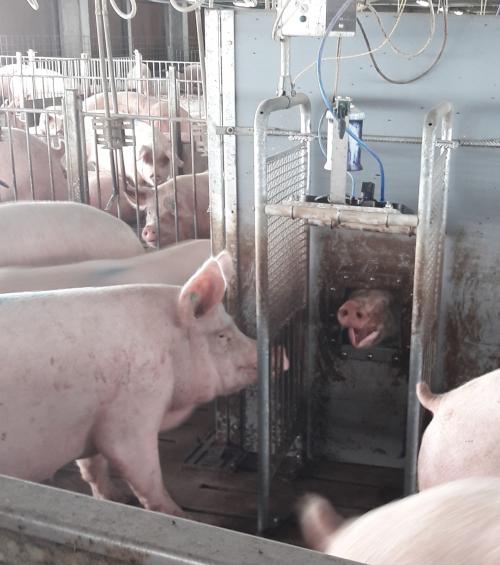Contact us now for advice from one of our experts in your region.

Limit lost production days in the gestation house with automatic heat detection
The technical key figures give a good impression of the management of the modern sow farm and offer a guideline for farmers to fine-tune their management strategy for even better technical and financial results.
One of these figures is the farrowing rate (the number of litters per sow per year). The farrowing rate is influenced by the length of the cycle, the duration of gestation and the length of lactation. A higher age at weaning lowers the farrowing rate. The length of time between weaning and the next moment of heat also affects the farrowing rate.
Sows returning to service cause loss of production days and affect the farrowing rate
A frequently underexposed reason behind a fall in the farrowing rate is sows that return to service (sows that fail to become pregnant after mating). A return to service can have several causes:
- No fertilisation has taken place.
- Fertilisation has taken place, but the embryos have been rejected.
- Insufficient number of embryos. If there are insufficient embryos in the uterus, the brain will fail to receive the correct hormonal signal and the pregnancy will be aborted.
In order to reduce lost days in the cycle, it is important to quickly identify sows returning to service as soon as they come into heat again. As well as lost production days, a sow in heat causes disruption in the group. This is especially true in static groups where the sows are all at the same stage of implantation. That is the most vulnerable stage of the pregnancy, with all the potential negative consequences.
Identify return to service early
The trained eye of an experienced stockperson can spot these sows easily. But what if you can't always be in the house yourself? Now that around the world housing pregnant sows in large groups is increasingly replacing crate and pen-based systems, early detection of sows returning to service is something that demands attention. In this case, automatic heat detection is a valuable tool.
HeatTek automatic heat detection
To automatically identify and mark sows in heat, Fancom offers HeatTek heat detection. HeatTek is an optional extension of the Intellitek Electronic Sow Feeding Station.

How does HeatTek work?
As soon as the sow in heat shows interest in the boar, HeatTek will recognise the sow using RFID technology. The teaser boar is in his own pen and poses no risk to safety. The sow in heat is registered. This is immediately reported to the stockperson. On her next visit to the feeding station, the same sow is recognised again and can be marked and even automatically selected so she can be taken to the mating pen quickly. Automatic heat detection works faster and more accurately and is safe for the stockperson. This makes HeatTek an excellent addition to group housing with feeding stations.
The benefits of HeatTek
- Accurate and quick identification of sows in heat
- No longer reliant on individual observation of different stockpersons
- Fewer lost production days improves the farrowing rate
- Calm group as sows are not kept unnecessarily long in group housing
Intellitek Sow Feeding Station
HeatTek is an optional extension to the Fancom Intellitek sow feeding station. The Intellitek stimulates the sow's natural behaviour and offers outstanding functionality for practical sow management. You can feed your animals individually according to their specific needs, keep feed costs in check and keep the animals in top condition.
Intellitek is part of Fancom's Smart Feeding solutions that help maintain an efficient feeding process throughout the entire sow cycle. Other systems are the FaroTek farrowing house feeding system and the Rondomat automatic feeder for weaned piglets.


Forward
thinking

